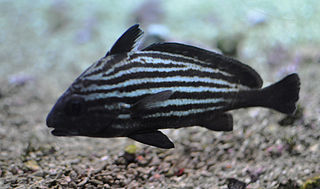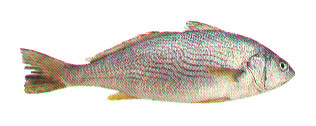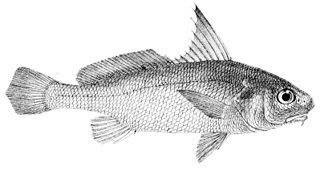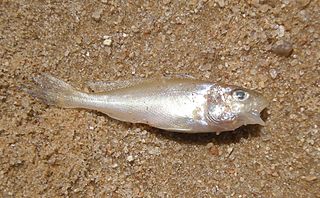
Menticirrhus is a genus of marine ray-finned fish belonging to the family Sciaenidae, the drums or croakers. They are commonly known as kingcroakers or kingfish. These fish are found in the Western Atlantic and Eastern Pacific Oceans.

Argyrosomus is a genus of marine ray-finned fishes belonging to the family Sciaenidae, the drums. The fish in this genus are large and are commonly targeted as game fish.

Micropogonias is a genus of marine ray-finned fishes belonging to the family Sciaenidae, the drums and croakers. These fishes are found in the eastern Pacific and western Atlantic Oceans.

Plagioscion is a genus of freshwater ray-finned fishes belonging to the family Sciaenidae, the drums and croakers. They are found in tropical and subtropical South America where they inhabit fresh and brackish waters. Some species are important food fish and support major fisheries.
The striped croaker, also known as the St Lucian corvina, is a species of marine ray-finned fish belonging to the family Sciaenidae, the drums and croakers. This species is found in the western Atlantic Ocean in the Caribbean Sea and Gulf of Mexico.

Cynoscion is a genus of marine ray-finned fishes belonging to the family, Sciaenidae, the drums and croakers. These fishes are found off the coasts of North and South America in the western Atlantic and eastern Pacific Oceans. Many fishes in this genus have been given the common name weakfish.

Pareques acuminatus, commonly known as the high-hat, donkeyfish, cubbyu, Steindachner's ribbonfish, streaked ribbonfish, striped ribbonfish or striped drum, is a species of marine ray-finned fish belonging to the genus Pareques in the family Sciaenidae, the drums and croakers. This species is found in the western Atlantic Ocean.

Sciaena is a genus of marine ray-finned fishes belonging to the family Sciaenidae, the drums and croakers. These fishes are found in the Eastern Pacific Ocean and the Eastern Atlantic Ocean.

Panna is a genus of marine ray-finned fish belonging to the family Sciaenidae, the drums and croakers. These fishes are found in southern and southeast Asia.

Corvula is a genus of marine ray-finned fishes belonging to the family Sciaenidae, the drums and croakers. These fishes are found in the western Atlantic Ocean and the central eastern Pacific Ocean.

Reeve's croaker, also known as the goldbelly croaker, golden corvina, yellowfin croaker or yellowfin corvina, is a species of marine ray-finned fish belonging to the family Sciaenidae, the drums and croakers. This species is found in the coastal waters of the Indo-Pacific region. It is the only species in the monospecific genus Chrysochir.

Umbrina is a genus of fish from the croaker family Sciaenidae. The genus contains 17 species occurring in tropical and warm temperate waters of the Atlantic, the Mediterranean, the Western Indian Ocean and the eastern Pacific.

Atractoscion is a genus of marine ray-finned fished belonging to the family Sciaenidae, the drums and croakers. The fishes in this genus are found in the Atlantic, Indian and Pacific Oceans.

The blackbar drum is a species of marine ray-finned fish belonging to the genus Pareques in the family Sciaenidae, the drums and croakers. It is found in the western Atlantic Ocean.

Johnius is a genus of marine ray-finned fishes belonging to the family Sciaenidae, the drums and croakers. They are commonly known as croakers due to their ability to produce purring, croaking and knocking sounds. The sounds are produced mainly at night and are thought to be either involved in defense or for courtship.

Odontoscion dentex, the reef croaker or brown large-eyed croaker, is a species of marine ray-finned fish belonging to the family Sciaenidae, the drums and croakers. It is found in coral and rocky reefs of the tropical Western Atlantic, living as solitary individuals or in small groups at a depth of 1 to 30 m. This species feeds on small fish, shrimp, and larvae.

Odontoscion is a genus of marine ray-finned fish belonging to the family Sciaenidae, the croakers and drums. These fishes are found in the Western Atlantic and Eastern Pacific Oceans.

Otolithes is a small genus of marine ray-finned fishes belonging to the family Sciaenidae, the drums and croakers. The three recognised species in the genus are found in the Indo-West Pacific region.

Pachypops is a small genus of freshwater ray-finned fishes belonging to the family Sciaenidae, the drums and croakers. The three recognised species in the genus are found in South America.
Paralonchurus is a genus of marine ray-finned fishes belonging to the family Sciaenidae, the drums and croakers. These fishes are found in the eastern Pacific Ocean with one species in the western Atlantic Ocean.
















